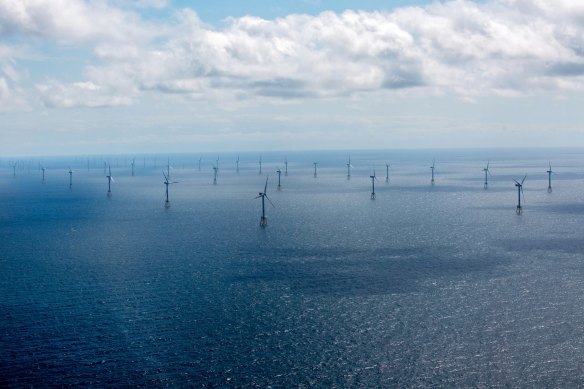Offshore gas and wind first real test for Minns government
By Laura Chung
The political warfare over the controversial PEP11 project is escalating, with NSW Labor facing its first major energy decision that could indicate how it plans to tackle the decarbonisation of the electricity sector.
At issue is the proposed offshore gas development known as Petroleum Exploration Permit 11, or PEP11, which is located 50 kilometres off the NSW coastline and covers an enormous area of 4574 square kilometres.

Australia’s coastlines offer a unique energy opportunity that companies are racing to get their hands on.Credit: Bloomberg
The project has been drawing political fire ever since the first test well was sunk in 2010 and was infamously bound up in the scandal surrounding former prime minister Scott Morrison’s adoption of his colleague’s ministries.
Now the NSW opposition has flagged the introduction of a bill that proposes preventing offshore exploration and mining. This would stop rigs in Commonwealth waters from connecting to the mainland, even if the state government supported the project.
If passed, it means projects in Commonwealth waters – anything that lies more than 5 kilometres off the NSW coastline – won’t be permitted to lay infrastructure within state areas. In the case of PEP11, it means the gas companies would need to find another way of getting their product to shore.
Previously, both sides of politics have indicated their opposition to the project. But for now, the proposed bill has left Labor in a difficult position. It is awaiting the decision of a joint NSW-federal government panel: the National Offshore Petroleum Titles Administrator (NOPTA).
The decision is expected soon, but government officials were unable to provide a firmer timeline.
The panel consists of federal and state resource ministers Madeleine King and Courtney Houssos, in which the federal government maintains the power of veto.
King said she would not make further commentary to protect the decision-making process. “The current government has one resources minister. Just one. This government is one that respects proper process and the courts, and won’t make the same mistakes Scott Morrison did,” she said.
Houssos said given the PEP11 project was before the joint authority, she would be unable to comment. But she added that any new legislation on offshore exploration and mining was a matter for the NSW cabinet and would be considered in the usual way.
NSW opposition spokesman for energy James Griffin said he expected the bill to be supported by Labor.
“This bill isn’t ‘gotcha politics’. We are simply following through on our pre-election commitment and longstanding policy. I know MPs from all sides who know that their communities want them to support this bill. Let’s just get on with it,” he said.
“The public, particularly in coastal communities, have made their views clear about offshore gas and drilling. This proposed legislation will provide certainty about the future of their coastlines by legislating the previous government policy banning drilling in NSW coastal waters.”
Professor Llewelyn Hughes of ANU’s Crawford School of Public Policy, a specialist in energy transition, said new gas projects are becoming increasingly contested as Australia looks to decarbonise its electricity sector. He said that as Australia moves to renewables, the domestic demand for gas will decline. Although, it will likely still be used as a back up supply resource.
But as Australia exports most of its gas, decisions made by Australia’s gas customers could determine how long the industry continues in this country.
“There are a lot of countries in our region that don’t have fully developed gas [projects] yet and are still reliant on coal, they are thinking about using more gas which will not help them get to net zero, or reduce emissions,” he said.
The proposed legislation for NSW would not affect offshore wind proposals – another energy source the state is exploring. In Australia, projects are still waiting to receive approval.
For example, BlueFloat Energy recently announced it had shifted its preferred NSW wind farm location north, from between Shellharbour and Clifton, to about 14 kilometres off the coast near Kiama.
The most advanced project is the Star of the South off the coast of Southern Gippsland, where seabed drilling has started in the Bass Strait to test the area’s feasibility.
If approved, construction could start about the middle of this decade, with the first power delivered before 2030 to align with the planned closure of Latrobe Valley coal power plants.
Andy Evans, who was the co-founder and chief executive of Star of the South and who is now leading another offshore wind farm company, OceanEx, said as coal is phased out, other industries will need to take their place. Offshore wind has surged in investment popularity as companies look to impress their shareholders with green projects, he said.
The project OceanEx is championing will be 20 kilometres off the coast of the Hunter region and visible from shore on clear days, while the turbines proposed for the Illawarra project could be slightly closer.
Get to the heart of what’s happening with climate change and the environment. Our fortnightly Environment newsletter brings you the news, the issues and the solutions. Sign up here.